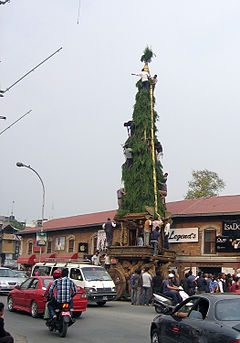Jana Baha Dyah Jatra
Jana Bāhā Dyah Jātrā (Devanagari: जनबाहा द्यः जात्रा) is the chariot procession of Jana Baha Dyah, the Bodhisattva of compassion, which is held annually in Kathmandu. It begins on the 8th day and ends on the 10th day of the bright fortnight of Chaulā (चौला), the sixth month in the lunar Nepal Era calendar.
The Buddhist deity is known in Sanskrit as Aryavalokitesvara (Sacred Avalokiteśvara), and also White Machhendranath or White Karunamaya. It is believed that the annual procession was begun to provide the townspeople who were unable to visit his temple a sight of the image.
During the festival, the image of Jana Bāhā Dyah is removed from his temple at Jana Baha and carried in a portable shrine to Durbar Marg from where the actual procession starts. There it is installed in the car built in the shape of a tower on wheels. The chariot is 35 ft
high.
When the image is placed on the chariot, a group of musicians from the Kansakar caste play a short fanfare on their long trumpets to announce the installation. At the same time, the Guruju Paltan, a ceremonial guard of honor consisting of soldiers dressed in ancient uniforms, performs a feu de joie with their muskets. Crowds then pull the chariot through central Kathmandu accompanied by musical bands.
The journey is performed in three stages to permit devotees to make oblations. Worshippers bring trays of offerings and light rows of butter lamps to honor the deity wherever the chariot stops. Sweet marjoram flowers (मूस्वां) are special offerings on the occasion.
On the first day, the chariot is pulled from Jamal, Durbar Marg through Bhotahiti to Asan where it makes an overnight halt. The next day, the chariot is pulled through Indra Chok to Kathmandu Durbar Square where it makes its second stop. On the third day, the chariot is pulled through Maru and Chikan Mugal to Lagan at the southern end of the historic section of Kathmandu.
...
Wikipedia

